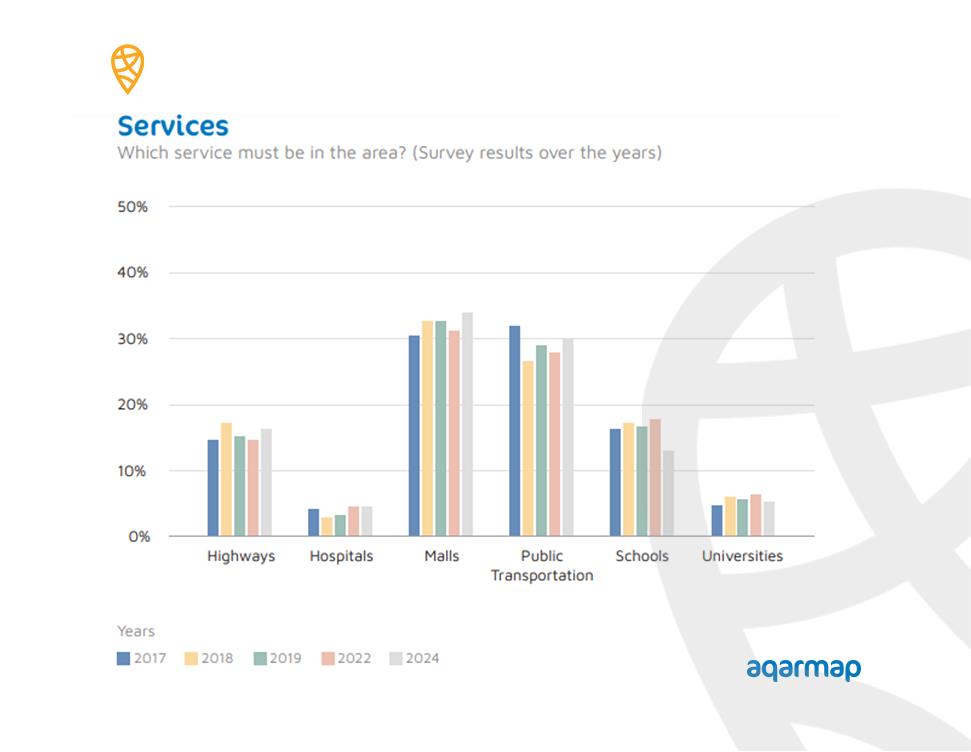
Homebuyers Favour Areas With Market, Transport Access: Aqarmap
In assessing the services that attract Aqarmap's real estate clients, the report shows that over 35% of middle- and high-income buyers prefer to live in areas with shopping centres. In contrast, a larger share of low-income buyers favours areas with public transportation options. The report also notes that high-income buyers show less interest in areas near universities and hospitals.
Additionally, the Aqarmap report highlights that nearly 80% of high-income buyers prefer to purchase homes in gated communities and residential areas with abundant green spaces.
The report concluded that 50% of low-income buyers prefer residential areas with ample green spaces. The remaining low-income buyers showed varying preferences for amenities such as daycare centres, clubs, shops, and malls.
According to the 2024 report, the proportion of buyers interested in purchasing homes in areas with water features and commercial shops has increased, while the demand for green spaces in residential areas and compounds has declined compared to the previous two years.
The Aqarmap survey presented the evolving preferences of real estate buyers for essential services in their chosen areas from 2017 to 2024. The results reveal a strong and consistent preference for areas with malls and public transportation, which have maintained high demand over the years. In 2024, around 35-40% of buyers rated these services as critical, indicating their importance in property selection.
The report also showed a moderate demand for proximity to schools, with around 15-20% of respondents prioritizing this feature, whereas the need for highways has varied slightly over time. Notably, hospitals and universities have consistently ranked lower on buyers' priority lists, each garnering around 5-10% preference, suggesting that these services are less influential in real estate decisions compared to retail and transport accessibility. This trend highlights a shift toward convenience-focused living, with buyers valuing easy access to shopping and commuting options over other amenities.
Moreover, the report showcased the top amenities preferred by different socioeconomic segments in residential areas. The data indicates a strong preference across all segments (A, B, and C) for green spaces, with nearly 80% of segment A (the highest socioeconomic group) prioritizing this feature. Segments B and C also show significant interest in green areas but at slightly lower percentages.
Other amenities vary in importance by segment. Social and sports clubs are moderately favoured, especially by segment B, while malls and shops hold a modest appeal across all groups. Segment C, representing the lower socioeconomic group, has a notable interest in basic amenities like shops, while features like smart home technology and water surfaces appear less critical for most groups, showing limited preference across the board. This suggests that greenery and accessible shopping facilities are key drivers for residential choice among Aqarmap users, with higher-income groups placing a particularly high value on green areas.
This study was based on the activity of Aqarmap's website and app users, with over 2 million monthly visitors searching for properties to buy or rent. The analysis covered more than 300,000 listings from real estate developers, marketers, and individual sellers.

Legal Disclaimer:
MENAFN provides the
information “as is” without warranty of any kind. We do not accept
any responsibility or liability for the accuracy, content, images,
videos, licenses, completeness, legality, or reliability of the information
contained in this article. If you have any complaints or copyright
issues related to this article, kindly contact the provider above.


















Comments
No comment